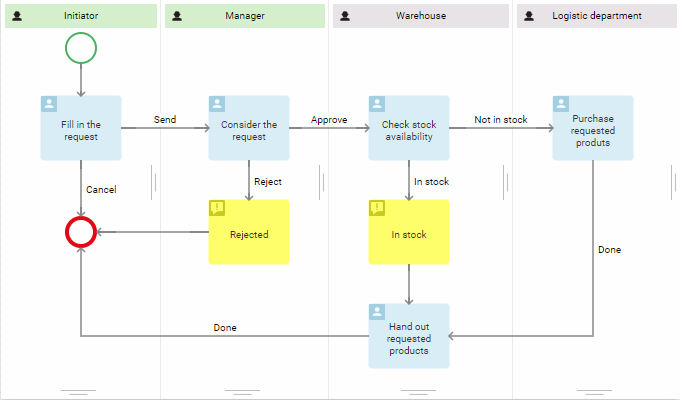The activities of any company can be viewed as a set of business processes. In order to manage the company’s work, you need to be able to describe, perform, monitor, and improve these processes.
What is a process
There are many definitions of this concept. We will use the following one:
A business process is a regularly recurring sequence of interrelated actions aimed at creating a certain product or service for customers. Note that by customers, we mean both internal and external ones.
Consider the following example. A bank provides loans to its clients. This is a business process with an external customer. When the same bank recruits a loan specialist, the customer will be the head of the department looking for a new employee. A business process like this satisfies the internal needs of the company.
Why we need to describe processes
Any organization has regulations and procedures that arrange and monitor the activities of employees. However, these regulations are often unclear and complicated for new hires. Apart from that, it can be difficult for managers to track the implementation of these regulations. This results in lower employee performance and decreases the whole company’s efficiency.
Business processes help you solve the problems mentioned above. By describing all procedures in the company in the form of business processes, you will make them transparent and understandable. Moreover, when describing processes, you might find some unnecessary operations that consume a lot of time and money and exclude them from the processes. By optimizing and improving business processes, you can improve the efficiency of the company.
How to describe processes
Processes can be described in the form of job instructions, but it’s preferable to use special notations. BRIX is based on the BPMN 2.0 notation. It allows not only describing the sequence of operations in a process but also defining its participants. This is undoubtedly one of the main advantages of the BPMN notation.
A business process in BPMN is a diagram. Each process participant is represented as a rectangle shape, or a swimlane. All tasks and events the process participant is responsible for are placed inside their swimlane.
Below is an example of a purchase process in BRIX:

Benefits
This approach allows representing the company’s operations as a chain of interrelated business processes rather than work of separate departments. Each step in this chain can be optimized so that it brings added value to customers and, consequently, ensures your competitive advantage.
In addition, business processes define ways that different departments can work together more effectively to achieve the company’s goals. They clearly define the roles and responsibilities of each participant in the process. Different departments do not need to compete for the same resources. As part of one process, they work together to achieve better results and increase productivity.
The described processes are easy to change and improve. Since the process is transparent and streamlined, it is easy to understand at what stage the improvement is needed, and what needs to be changed. A company that is able to quickly adapt to the changing market gains a competitive advantage.
Finally, described processes can be automated with the help of such BPM systems as BRIX. Automation allows you to reduce risks associated with human errors, save time and increase productivity. All tasks will be assigned to employees automatically, in the order specified on the diagram. This means that all steps of a process will be completed, and you will get a predictable and high-quality outcome.
Found a typo? Select it and press Ctrl+Enter to send us feedback